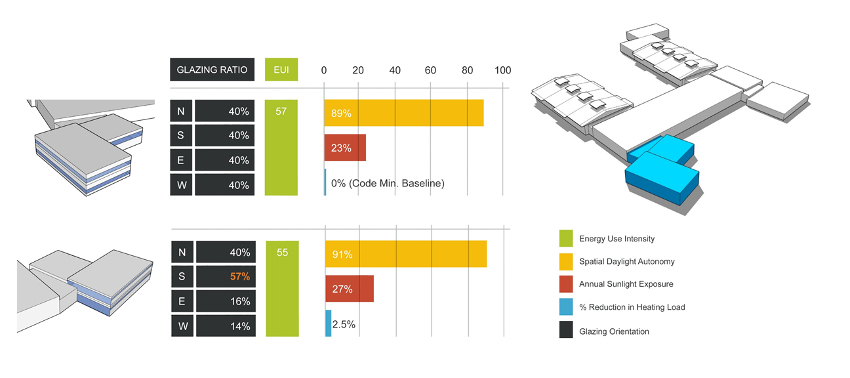Emerging Building Envelope Solutions You Can Use Today
Design Performance Modeling
The building design and construction industry is becoming ever more attuned to high-performance outcomes. Design teams and clients alike are becoming more sophisticated with regard to building science and energy conservation measures. Consequently, there is a growing expectation that project teams leverage the tools and technical resources necessary to go beyond oversimplified rules-of-thumb toward optimized building solutions grounded in performance-driven outcomes as part of an integrative design process.
Increasingly, energy modeling—once the purview of engineers late in the design process—is being utilized as a decision-making tool from conceptual design through construction. This kind of early-stage energy modeling—often referred to as design performance modeling—is simplified through basic forms, generalizations and gross approximations, which makes it markedly different from the highly detailed comprehensive energy modeling effort typically executed near the end of the design process for green building certification and/or energy code compliance.
Software developers are meeting demand head-on. An emerging marketplace of easily accessible software tools is liberating early-stage design performance modeling opportunities for the entire design team. Many publicly funded research institutions provide specialized analysis tools for free, while various commercial developers offer more robust, comprehensive packages. Several design performance modeling tools are now available that integrate into project team workflows with building information modeling (BIM). Thanks to these platforms, any designer can compare the performance of various design options and refine strategies.
These early-stage tools are easy to use, the results are visually stimulating and online tutorials abound. However, the validity of the results—albeit preliminary in nature—necessarily hinge on the user’s knowledge in regards to building science. In application, much like construction costs estimating, projects teams must also acknowledge that energy models are only as accurate as their inputs and more refined information (and thus more accurate results) will be available later in the design process.
As part of an integrative process, design performance modeling provides teams with a dynamic opportunity to compare the relative performance of different building forms and envelope options at the earliest stages of design when most of the major decisions are made and the consequences of significant changes are minimal.

Original image courtesy of the American Institute of Architects
Stages of Design and Types of Energy Models
Figure adapted from An Architect’s Guide to Integrated Energy Modeling in the Design Process, p. 8.
The Emergence of Building Enclosure Commissioning (BECx)
Over the past few decades, a growing importance of building envelope performance has been evidenced by the increased attention being paid to this topic by the building design and construction industry.
In 2004, the National Institute of Building Sciences (NIBS) Building Enclosure Technology and Environmental Council (BETEC) and the American Institute of Architects (AIA) signed an agreement to establish the Building Envelope Council (BEC) initiative.
The initial goal of the initiative was to have local AIA components establish at least nine BECs by May of 2007. Since then, the program has founded 26 BEC Chapters, representing both cities and states. Today, more than 3,000 affiliated architects, engineers, contractors, manufacturers and others with an interest in building enclosures participate in BECs around the country. The councils promote the exchange of information and facilitate discussion on topics pertaining to building enclosures and related science such as education, training, technology, climate conditions, local issues and more.
As a resource toward this effort, the NIBS, under guidance from the Federal Envelope Advisory Committee, developed a comprehensive guide for building envelope design and construction for office and institutional building types. The Building Envelope Design Guide (BEDG) is continuously improved and updated by the BECs and can be accessed (for free) through the online Whole Building Design Guide (WBDG), a program of the NIBS.
A development in the work of the BETEC is the creation of NIBS Guideline 3 for the Building Enclosure Commissioning Process BECx. NIBS Guideline 3 is intended to be used in concert with ASHRAE Guideline 0.










